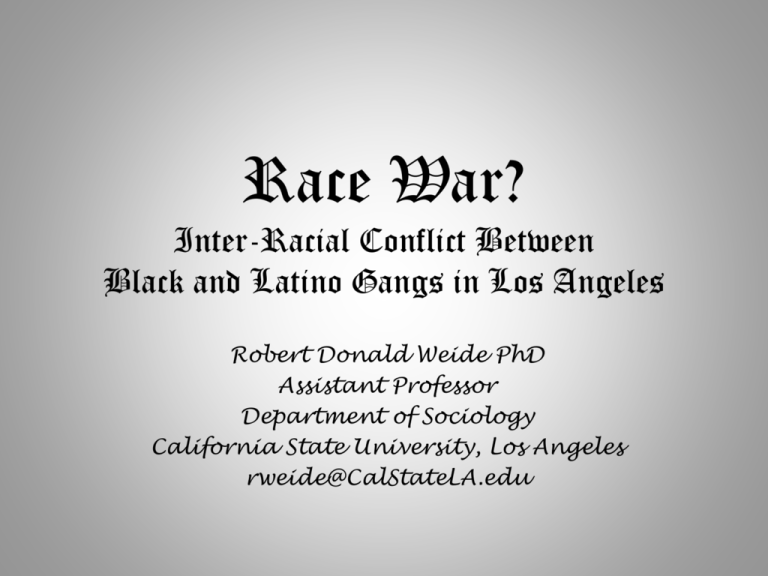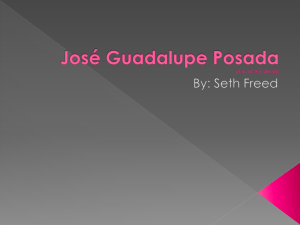Race War? Conflict Between Black and Latino Gangs in Los Angeles
advertisement

Race War? Inter-Racial Conflict Between Black and Latino Gangs in Los Angeles Robert Donald Weide PhD Assistant Professor Department of Sociology California State University, Los Angeles rweide@CalStateLA.edu A Sociological Narrative • What is sociology? What do sociologists do? • The power of sociology is in the analysis not in the data • “Neither the life of an individual nor the history of a society can be understood without understanding both.” – C. Wright Mills, The Sociological Imagination • A History of Crossroads: Historical Antecedents to Racial Gang Conflict in Los Angeles and California State Prisons – – – – – Spanish Colonization and the Roots of Racial Bias in Mexican Culture: late 1400s – 1848 The Anglo Invasion: 1848 – early 1900s Populating Los Angeles: early 1900s – 1950s The Rise and Collapse of the Civil Rights Movement: late 1950s – early 1970s Inter-Racial Gang Conflict on the Streets of Los Angeles: early 1990s – Present Spanish Colonization and the Roots of Racial Bias in Mexican Culture: late 1400s – 1848 • 15th century Spain and the Reconquista (1492): Birth of the race concept – Race is a concept conceived of for the purpose of dividing human beings into stratified social groups • The African Slave trade in Colonial New Spain (Mexico) – 200,000+ African slaves were imported to Mexico – Mexico accounted for half of all African slaves imported to the New World until 1700 – Regions like Veracruz, Zacatecas and the District Federale (Mexico City) were common destinations for African Slaves – 1612 DF Population: 15,ooo Spanish, 80,000 Indigenas, 50,000 African – Regime of social, economic, legal and cultural restrictions of Afro-Mexicans throughout colonial period – The “Mestizo Myth” and complexion bias in modern Mexican society Famous Afro-Mexicans include Emiliano Zapata and Don Pio Pico The Anglo Invasion: 1848 – early 1900s • • The Mexican American War and the Treaty of Guadalupe Hidalgo (1848) The Anglo Horde Arrives: The Gold Rush of 1849 – Hundreds of thousands of Anglos pour in from the East Coast and the South – Mexican Californios go from majority to minority virtually overnight – Anglo immigration increased California population by over 410% in 10 years, and 1600% in 50 years – 1850 – 92,597 – 1860 – 379,994 – Some Anglos from the South brought African American slaves with them • Stolen Land – Dispossessing Californios through homesteads and hustles – Mexican property titles were ignored – Court cases always favored Anglos as juries were composed exclusively of Anglos – Dispossessed Mexicans and blacks concentrated in Downtown and regional barrios • The imposition of the Anglo American system of racial stratification – Blacks and Mexicans ended up in the same subordinate class position The Birth of the Ghetto: early 1900s – 1950s • Housing Covenants: a history of geographical isolation for African American and Mexican American communities – Anglo development Downtown pushed the Mexican community to East LA and the black community to South Central – Housing covenants were laws that forbade the selling of property to non-white persons – Housing covenants were the law in Los Angeles until they were ruled unconstitutional by the SCOTUS in 1948 – Neighborhood racial boundaries were enforced for a generation afterward by racist white residents and LEO’s – “The Spook Hunters” one of the earliest documented gangs in Los Angeles. Intimidated and terrorized blacks who dared to enter white neighborhoods – Geographical isolation enabled the emergence of distinct black and Chicano cultures in South and East LA respectively The Rise and Collapse of the Civil Rights Movement: late 1950s – early 1970s • “I have a dream” Martin Luther King Jr. 1963 – The Civil Rights Movement began as a movement denouncing the race concept • Ian Haney-Lopez – Legal violence and racist suppression of the Civil Rights Movement led to the radicalization of the movement • COINTELPRO – FBI and ATF infiltration and suppression of radical civil rights organizations like the Brown Berets and Black Panther Party left a void in Los Angeles society that was filled by gangs • Racial Nationalism: Viva La Raza and Black Power – Radical civil rights organizations like the Brown Berets and Black Panther Party called for the emphasis of insular oppositional racial identities, rather than the dissolution of the race concept – Insular oppositional racial identities complemented the geographical isolation and cultural divide between black and Chicano communities in Los Angeles – Informed the emergence of modern Crip, Blood and Sureno gang identities Radical Civil Rights Organizations: The Brown Berets and Black Panther Party An Invisible Wall: Cultural Differences Between Black and Chicano Communities in Los Angeles • • • • • • • Clothing Hairstyles Language Music Cars Cuisine Religion • • • Cross-racial membership: Black South Siders, Mexican Crips and Bloods Cultural identity determines racialized gang identity, not primordial racial identity “It ain’t what you are, it’s where you’re from” Demographic Change in Los Angeles • Demographic Change – Massive Latino immigration since 1970 Los Angeles County Population by Race 1940-2010 6000000 5000000 4000000 Asian Hispanic 3000000 Black White 2000000 1000000 0 1940 1950 1960 1970 1980 1990 2000 2010 Competition Bias • • Both Black and Mexican gang members see one another as competition for jobs and housing, however for very different reasons Sureno Crip and Blood Employment Competition 44/60 – 73% 19/26 – 73% Housing Competition 44/62 – 71% 19/27 – 73% Black gang members resent Mexican immigrants for taking jobs and housing – – • Perceptions of Black gang members think Mexican coworkers are too willing to be taken advantage of by employers, which puts Black workers in a difficult position of having to compete by being taken advantage of White employers and landlords prefer Mexican workers /tenants over Black workers/tenants Mexican gang members believe that Blacks are lazy and dependent on welfare, which Mexican immigrants are ineligible to receive – Mexican gang members think Black coworkers complain more than they work and keep their jobs only by the threat of alleging racial bias against employers Competition Bias • Black Perceptions What tends to happen is a lot of the Mexican workers are, what I don’t like about working with them is that, they, overcompensate and course an employer would like to get as much as they can out of an employee, so, if work starts at 7, what bothers me is that they’re there at 5:30, and they’re working Q: To make everybody else look bad? A: Right, or make themselves look good, either way, and it’s not fair because even though I’m not penalized directly for that, starting at 7, but of course if you’re the boss and you getting production out of these guys keep ‘em even later, get off at 3:30, they’re still there at 4, 4:30, circumstances may need for that if there’s, you gotta clean up something, something went wrong, but just because you know, quit time is quit time, pick it up tomorrow, you know not just because you want brownie points. #69 WS Rolling 20’s Bloods, 40’s • Mexican Perceptions A: A lot of these black fools I’ve worked with they like to just kick back. They like to take it easy, or they always bring the race card in and bring up fuckin slavery. But you know what, slavery’s been gone for like 500 years so get over it. They always complain about being slaves and shit. You know what they like to complain a lot. It’s like, do your fucking job and work. We’re here to work so work. From my experience they’re lazy. I would always take a Mexican or Latino over a black any day to do a job because they actually bust their ass. Q: Do you think blacks have an attitude problem at work too? A: Yeah of course. Like I said they’re always complaining about something. Like they feel like slavery is still existing here in America. Get over it aye, that shit was over 500 years ago.! #02 ES State Street 13, 40’s Inter-Racial Gang Conflict on the Streets of Los Angeles: Early 1990s – Present • • Major Conflicts between Sureno and Crip and Blood affiliated gangs (in most cases) developed out of the distribution and retail of narcotics in demographically mixed areas West Side 18 Street vs. Black P Stones (Bloods) – – – – • Mid-City and Baldwin Village (The Jungles) Began in 1994 due to competition for a lucrative narcotic retail location 18 Street ruled by Mexican Mafia member Francisco “Puppet” Martinez 18 Street allied with BPS enemies Hoover Criminals (Crips) and Rolling 30’s Harlem Crips South Side Florencia 13 vs. East Coast Crips – South Central, Huntington Park and Florence-Firestone – Began in 2004 due to a drug deal gone bad where ECC members absconded with a significant (multi-kilo) quantity of cocaine from Florencia 13 members working for the Mexican Mafia – Florencia 13 ruled by Mexican Mafia member Arturo “Tablas” Castellanos – Florencia 13 allied with ECC enemies Pueblo Bishop Bloods Francisco “Puppet” Martinez and Arturo “Tablas” Castellanos A Radical Theory of Hegemony: The Hegemony of Mutual Destruction • “Part of the mechanics of oppressing people is to pervert them to the extent that they become the instruments of their own oppression.” – Kumansi, former Slausons member, longtime South Central resident and civil rights activist • Divide and Conquer – Preventing potential resistance to capitalist exploitation by distracting marginalized populations from their common interests • Emphasizing racial and gang identities over class solidarity • A surplus labor problem that solves itself by occupying marginalized communities in perpetual conflict with each other and themselves Parallels with Gangs in Denmark • Some of the gang conflicts in Denmark are between native and foreigner gangs • Modern refugee and immigrant populations in Denmark are the result of historical and contemporary European colonial policies • Historical racial bias against foreigners informs the perspective of Native Danish gangs • Cultural differences between native and foreign Danish gangs frame the animosity between them (although of course few gangs are racially exclusive) • The Hegemony of Self-Destruction: working class native and foreign gangs fighting one another prevents them from becoming politically conscious and prevents solidarity between the two major working class populations in Denmark






